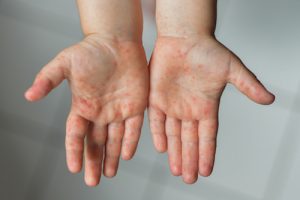Do You Have Rashes and Swelling on Certain Parts of Your Body? You Could Be Dealing with Angioedema or Urticaria

If you are experiencing swellings and raised rashes that appear all of a sudden on certain parts of your skin, then you could be dealing with angioedema or urticaria. These can be serious skin issues because if the swelling occurs in the mouth or throat, it could result in not being able to breathe. Learn about the symptoms, causes, and treatment options. Then contact Allergy, Asthma, and Immunology Medical Group at 805-658-9500 for additional help.
The Basics of Angioedema and Urticaria
These are actually two separate conditions but they are related. Angioedema involves swelling under the skin and often presents around the mouth, tongue, eyes, genitals, lips, feet, and hands. Urticaria refers to the raised red bumps and patches that many refer to as hives. In most cases, both of these cases are related to allergies but other health issues can be involved too.
Common Symptoms of Angioedema and Urticaria
It is common for symptoms to appear within a few minutes after a person has been exposed to the irritant, though it can come several hours later. It could be that there are symptoms only in one part of the body, or that there are symptoms in several body parts. Some of the most common symptoms include:
- Swollen eyes
- Drop in blood pressure
- Rash on the hands, feet, forehead, or groin
- Rattling or wheezing breath
- Swollen tongue
- Throat closure
- Swollen sinuses
- Asthma symptoms
- Runny nose
- Runny eyes
Potential Causes of Angioedema and Urticaria
In most cases, allergens cause these conditions but some types of allergens are more commonly the cause than others. Additionally, there can be non-allergen causes. Some of the most common causes include latex, food allergies to shellfish, peanuts, and soybeans, allergies to medications, and genes.
How We Treat These Conditions
The first step is for us to diagnose what you are dealing with. We do this by getting a full health history and talking to you about any foods or medications that you may have taken before the issue began. If we cannot determine the cause of that, we may do a skin test or blood test to narrow down the cause.
Once we know what the issue is, we will help find the treatment plan that will work best for you. This could involve avoiding the allergen, taking medications, or both. When you choose to work with Allergy, Asthma, and Immunology Medical Group we will create a clear, easy-to-follow treatment plan so that you know exactly how to stay safe. Contact us at 805-658-9500 now to get started.



